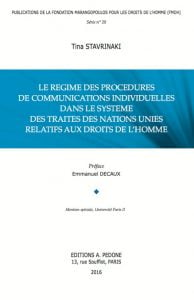
CYPRIOT CASES BEFORE THE ECtHR: A PRACTICAL GUIDE
Project on Foster transparency of judicial decisions and enhancing the national implementation of the ECHR
Author(s): Stavrinaki, Tina
The empirical construction of the system of the United Nations Human Rights Treaties is founded on a consensus among States, also covering the established Committees by these instruments.
Nine UN instruments on human rights entrust their respective monitoring body to examine individual communications and they materialise the emergence of a right to an international remedy. Among the procedures provided by the two Covenants and the procedures of specialised treaties, a vast normative system is made available to litigants. The multitude of conventional procedures of individual communications offers a diversity of choices to individuals and groups of individuals and, according to some, puts in danger the unity of international human rights law, taking into consideration that the same allegations can fall under more than one procedures.
Safeguarding the object and the purpose of the UN human rights treaties, and the effectivity of individual communications, the Treaty Bodies reinforce their role as monitoring mechanisms and encourage an implicit judicialisation of the contentious procedure. However, in the absence of institutional tools making it possible to impose on States parties the obligations arising from the individual communications procedure, the Treaty Bodies are obliged to seek the right balance between firmness and diplomacy without being able to ensure the cooperation of the States parties.
The book at hand is the first one examining in a synthetic way all the individual communication procedures established pursuant the UN Human Rights Treaties. The organisation and evolution of the UN Treaties system provide the backdrop to this reflection, allowing the reader to understand the functioning and interaction of the Committees and to reflect on the recurring problem concerning their future. Except for the exhaustive examination of procedural questions, which constitute a tool for practitioners, this research analyses, on the one hand, the Treaty Bodies’ contribution to the evolution of international law and clarifies, on the other one, the relationship among the Committees and the regional Courts of human rights.
“Dedicating her thesis to the regime of “individual communications” within the UN human rights system, Tina Stavrinaki reveals a real challenge. It is an understatement to say that her exhaustive research comes at the right time, when theoretical and practical, legal and diplomatic, international and internal debates are multiplying, on a system which remains largely ignored. It would be an understatement to say that such a thesis fills a gap; it explores a terra incognita of the doctrine, particularly in the French language”. (En excerpt of the preface of Emmanuel Decaux)
